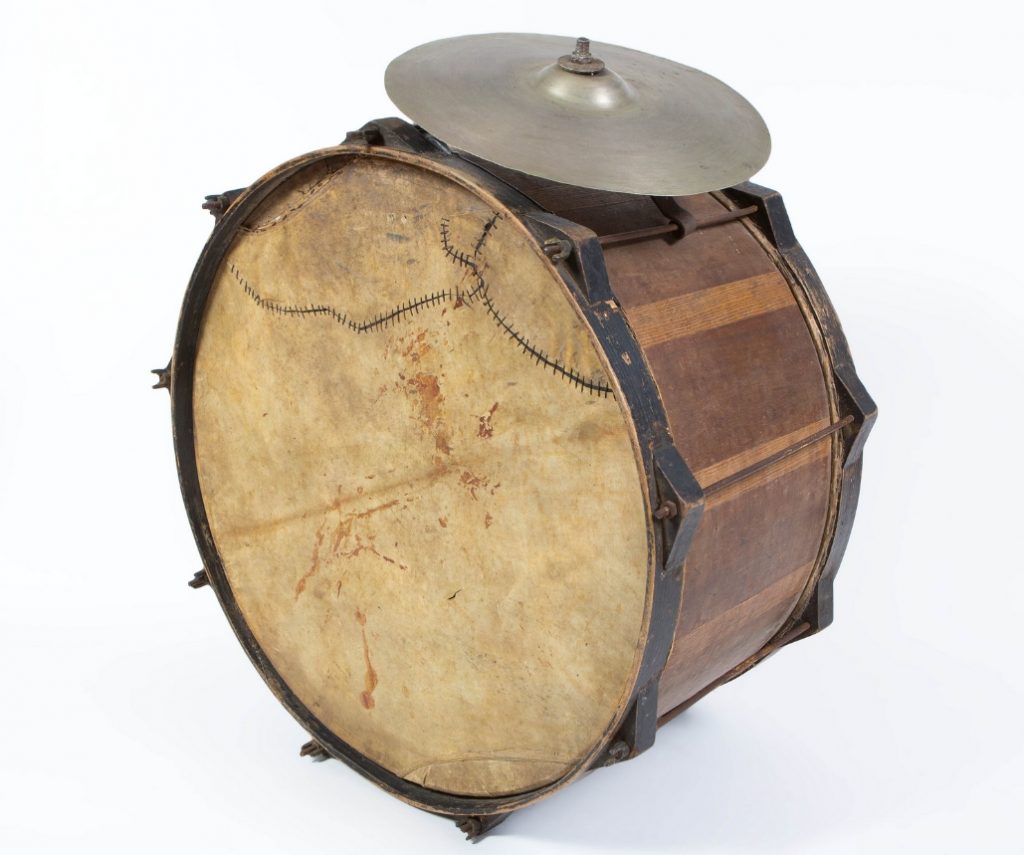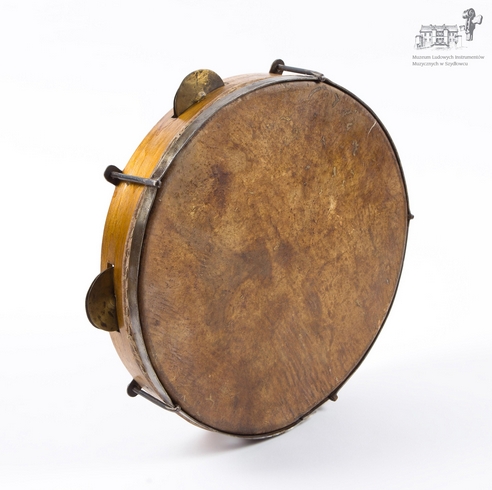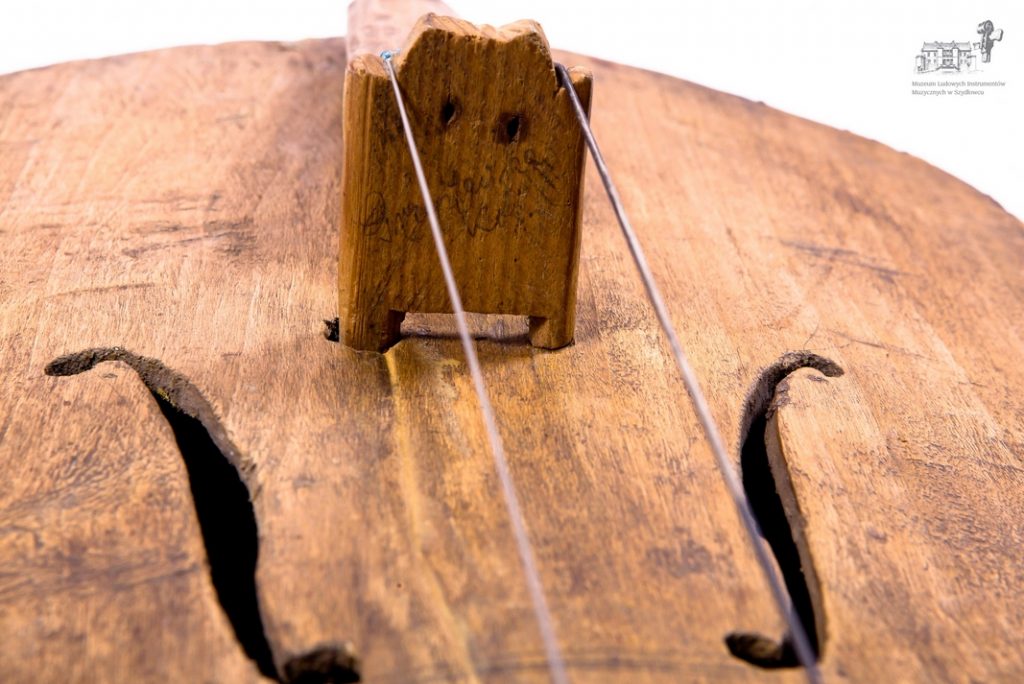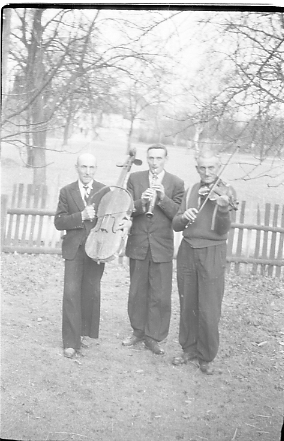Drum’n’Bass
|
The fiddle plays the most prominent role in Polish traditional music (sometimes a fiddler was enough to provide music at a wedding party), yet several other instruments have acquired prominence in several specific regions: the bagpipe in Podhale, Greater Poland (Wielkopolska), Beskid Żywiecki and Silesia or the dulcimer in Rzeszowszczyzna and Masuria (Mazury). On the other hand, the double bass and the drum have sometimes been regarded as lesser, secondary instruments, which only provide the accompaniment. Yet is the double bass and the drum that we will look at today rather than the first fiddle, as dancers find the rhythm equally important as the melody.
A double-skin drum with a cymbal from the collection of the Franciszek Kotula Ethnographic Museum in Rzeszów, photo by W. Kielichowski (Institute of Music and Dance). Obviously, the fiddle is an essential instrument, but only the poorest wedding parties employed a single fiddler to provide musical entertainment. Normally there was also a double bass and/or a small drum, and sometimes additional instruments as well (e.g. the clarinet). Interestingly, the fiddler would sometimes bring along a double bass and a drum, and then ask the household members to “do the bass”. Both instruments – the drum and the double bass – basically play the rhythmic part, as on several occasions the strings of the double bass are not shortened.
A single-skin drum from the collection of the Museum of Musical Instruments in Szydłowiec, photo by W. Kielichowski (Institute of Music and Dance). Polish instrumentation includes a range of different percussion instruments, such as small single-skin and large double-skin drums, as well as a percussion set called dżaz. Today we will mainly focus on double-skin braced drums. But before we go on to describe these rare instruments, let us start with the double bass, including a very peculiar type called basy kaliskie (Kalisz-style double bass). We have just highlighted the region of Kielce (Kielecczyzna) on our blog, but today we are going to concentrate on drums and double basses from the region of Kalisz (Kaliskie). Imitating the sound post Wielkopolska is traditionally famous for its bagpipes. However, the region includes several subregions where the bagpipe is virtually non-existent. One of such places is Kalisz Land (Ziemia Kaliska) with its characteristic double-string bass hollowed out of one piece of wood, called basy kaliskie (Kalisz-style double bass):
The body of a Kalisz-style double bass, photo by J. Lisakowski © Phonographic Collection of the Institute of Art at the Polish Academy of Sciences The instrument has been discovered for the rest of the world (including the ethnomusicologists) by researcher Jarosław Lisakowski. The instrument’s peculiar quality is not only the fact that it is hollowed out of one piece of wood, but – most importantly – by the archaic form of its bridge, whose one foot leans against the instrument’s top board and the other one runs through the hole in the soundboard and, while imitating the sound post, touches the bottom board of the instrument.
The bridge of a Kalisz-style double bass, photo by W. Kielichowski (Institute of Music and Dance). Jarosław Lisakowski has emphasised the ancient origins of the bridge and pointed out that the same construction is found in the Welsh crwth. The reconstruction of the suka biłgorajska (suka from Biłgoraj) and more recent archaeological discoveries have proved that this type of bridge is quite characteristic of lap vielles, such as the suka biłgorajska and the fidel płocka (vielle from Płock). Similar to the other types of double basses found in various parts of Poland, the Kalisz-style double bass has been an ensemble, rather than a solo, instrument. The most popular ensembles from the area of the River Prosna consisted of a fiddle and a double bass or a fiddle and a small drum. An ensemble could be extended to a trio of a fiddle, a drum and a double bass or a fiddle, a double bass and an E-flat clarinet. The latter type of arrangement can be seen in the picture below showing the renowned Kapela z Ołoboku (Ołobok Ensemble):
Kapela z Ołoboku (Ołobok Ensemble): Władysław Banasiak, Edmund Ciupek, Józef Schmidt, photo by J. Lisakowski 1959, © Phonographic Collection of the Institute of Art at the Polish Academy of Sciences The ensemble can be heard on CD – Melodie stamtąd. Nagrania archiwalne pieśni i muzyki regionu kaliskiego ze Zbiorów Fonograficznych Instytutu Sztuki PAN. Cz. 1: 1947–pierwsza poł. 1959 r. (Melodies from out there. Archival songs and music from Kaliskie from the Phonographic Collection of the Art Institute at the Polish Academy of Sciences. Part 1: from 1947 to the first half of 1959) Contemporary Kalisz-style double basses have been built by Mateusz Raszewski. They appear in his own ensemble Gołoborze, in which they are performed by Marcin Małecki. The ensemble is sometimes augmented by Leon Lewandowski, a fiddler born in 1926 (!). Leon Lewandowski – fiddle, Mateusz Raszewski – double bass, Piotr Rogaliński – drum: In the archival recordings of both Kapela z Ołoboku and Kapela Gołoborze, which still performs in concert and at dancing parties, the double bass normally fulfils the rhythmic role, whilst the harmony is usually assigned elsewhere. The reason for this fact is that the strings of the Kalisz-style double bass, contrary to those of the fiddle, are not shortened. In effect, the bourdon sound they produce always maintains the same pitch. Braced drums Kaliskie can boast two different types of drums: a small single-skin drum with clankers and a braced double-skin drum. Similar to the Kalisz-style double bass, we owe the first mention of the latter to Jarosław Lisakowski and his 1950s research (conducted alongside his wife Irena and a team including Anna Szałaśna). One of the most characteristic features is an archaic method of fixing and stretching the instrument’s skin with a brace (hence the name).
A double-skin braced drum from the collection of the Museum of Musical Instruments in Poznań, photo by W. Kielichowski (Institute of Music and Dance). Drum and bass Can traditional music drums and double basses only be reduced to the supplementary role of accompaniment instruments that may easily be dispensed with? In theory, they can… The dancers, however, may think otherwise. When it comes to dancing, rhythm and pulse, supplied by those ‘secondary’ instruments, come to the fore with the best drummers becoming the leaders of the ensemble! In August 1950, Jadwiga Sobieska gave the following opinion about the drummer (and fiddler) Adam Korczak: Korczak Adam is a village blacksmith. A slim figure, hair once black, now greying, a black moustache, vibrant glistening happy pitch-black eyes. Before the performance, the old maestro rubs the skin of the drum with rosin, „so that it gives voice”. He plays with a small stick, with his wrist and his hand, utilising the drum’s potential in the most masterful fashion. He plays the tremolo, he imitates the drone of the bass, he juggles his instrument all around. During the First World War, Korczak played in an Austrian military orchestra as a drummer and probably as a trumpeter, and he was already an excellent musician arousing admiration from the listeners, including the generals. (Quotation from recording reports, source: Phonographic Collection of the Institute of Art at the Polish Academy of Sciences). More recently, the world of Polish folk music has been graced by the extremely talented drummer Cezary Bursa, who plays alongside his brother and his father in their own family ensemble Kapela Bursów from Guzów: It needs to be emphasised that although drums and double basses normally provide support and accompaniment for the solo instruments, the sound of most traditional Polish ensembles could not be the same without them. |









